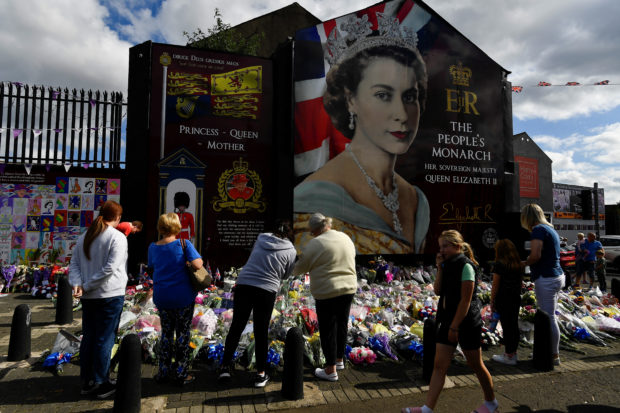Northern Ireland loyalists anxious as ‘stalwart’ queen passes

People stand next to flowers left in tribute, following the passing of Britain’s Queen Elizabeth, in Belfast, Northern Ireland, September 10, 2022. REUTERS FILE PHOTO
BELFAST — Loyalists laid flowers by a huge mural of a young Queen Elizabeth in a fiercely British corner of west Belfast, looking back at what they saw as a glorious past, and forward to what they feared was an uncertain future.
A few hundred meters away, across steel and concrete “peace walls”, many Irish nationalists reacted to the death of a woman they once saw as a symbol of British oppression with indifference or, at most, polite sympathy.
Elizabeth was queen for 70 of Northern Ireland’s 100 years of history, and for all of three decades of the “Troubles” in which more than 3,000 died in sectarian fighting.
Opinions of her have always been as divided as the territory. Reflections on her death have touched on how much Northern Ireland has changed since her heyday, and how diminished the crown’s role might be during the reign of her son.
Loyalists, who want to keep the region under British rule, remain among the royal family’s most devoted subjects.
“It’s part of our culture here … monarchy is a big, big thing. And the queen is the monarchy, as far as we’re concerned,” said Bill Martin, 75, who drove 30 miles to take pictures of the royal shrine with an iPad.
“She was a real stalwart for the United Kingdom. I don’t think Charles is anywhere near that. He has no interest in Northern Ireland,” he said.
‘Anxiety of the unknown’
The queen’s death comes at a difficult time for loyalists and their more moderate unionist allies.
Sinn Fein, the former political wing of the Irish Republican Army, horrified many loyalists in May by securing the largest number of seats in the regional parliament for the first time.
The party has said a referendum on letting Northern Ireland join a united Irish state should be held within a decade as demographics and antipathy to Brexit boost support for the project, which polls show is most popular among the young.
For loyalists, the queen was the final direct link to both the Empire and World War Two victory central to their identity.
She was also seen as a constant amid perceived betrayals by British governments – from the Anglo-Irish Agreement in 1985 that gave Dublin a say in Northern Ireland affairs, to then Prime Minister Boris Johnson’s abandonment in 2019 of a pledge to never accept an Irish Sea trade border.
“I think there’s anxiety of the unknown, but that’s normal,” said Doug Beattie, leader of the second largest unionist party, the Ulster Unionists, speaking beside a painting of the queen in his constituency office southwest of Belfast.
“The queen seemed to be the glue to the whole of the union, the four nations. So there was always that sense … if you take away that glue, you get a sense of maybe, maybe things are weaker,” he said.
“But I am not necessarily sure that is necessarily the case. With a new king there could be continuity. We have to just wait and see.”
Reaching out to nationalists
A potent symbol of the union, the queen in her later years became a major force for reconciliation with its Irish nationalist foes, with her state visit to Ireland in 2011 the first by a monarch in almost a century of independence.
Two striking gestures on that trip transformed her relationship with Ireland: laying a wreath in honor of Irish people killed fighting for independence from Britain and using a few words in Irish in her speech at Dublin Castle.
“There was a lot of stuff washed away by the queen’s visit in 2011,” said Brian Feeney, an Irish nationalist columnist. The queen’s role as bogeyman for nationalists has long passed, he said.
The queen, whose cousin Lord Louis Mountbatten was killed by the Irish Republican Army in 1979, went even further a year after her state visit by shaking the hand of IRA commander Martin McGuinness, Sinn Fein’s Northern Ireland leader at the time.
The gesture “almost cemented the peace process” 14 years after the 1998 Good Friday Agreement largely ended the violence, said Peter Sheridan head of peace-building organization Co-operation Ireland who organized the event and was meters away when the two shook hands.
“Where else could you (go) after that in terms of top-level endorsement of peace and reconciliation?” he said.
While some Irish nationalists in bars reportedly cheered the news of the queen’s death and some fireworks were heard in Belfast, the reaction in nationalist areas was relatively muted, some saying the queen was irrelevant and others that she was little more than a celebrity.
Sinn Fein called on supporters to be respectful and said they were looking forward to working with Charles.
“There’s still people that are happy that she’s gone … but no celebrating the way there was when (former British Prime Minister) Margaret Thatcher died” in 2013, said Matthew Mullan, a 19-year old walking on the nationalist Falls Road in West Belfast.
For most nationalists, she’s now seen as a normal person, he said, “someone’s mummy, auntie, granny, you know what I mean.”
RELATED STORIES
Death of Queen Elizabeth II: What happens next?
New monarch gives fresh impetus to Scotland’s independence debate